
Ashoka, also known as Ashoka the Great, was an Indian emperor of the Maurya Dynasty, son of Bindusara, who ruled almost all of the Indian subcontinent from c. 268 to 232 BCE. Ashoka promoted the spread of Buddhism across ancient Asia. Considered by many to be one of India's greatest emperors, Ashoka expanded Chandragupta's empire to reign over territory stretching from present-day Afghanistan in the west to present-day Bangladesh in the east. It covered the entire Indian subcontinent except for parts of present-day Tamil Nadu, Karnataka, and Kerala. The empire's capital was Pataliputra, with provincial capitals at Takshashila and Ujjain. Ashoka, after the war of Kalinga, got upset with the bloodshed and vowed to never fight again. He patronized Buddhism during his reign.

Sanchi is a Buddhist complex, famous for its Great Stupa, on a hilltop at Sanchi Town in Raisen District of the State of Madhya Pradesh, India. It is located in 46 kilometres (29 mi) north-east of Bhopal, capital of Madhya Pradesh.
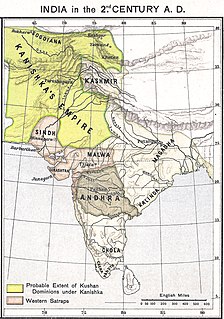
The Kushan Empire was a syncretic empire, formed by the Yuezhi, in the Bactrian territories in the early 1st century. It spread to encompass much of modern-day territory of Afghanistan, Pakistan, Nepal and northern India,at least as far as Saketa and Sarnath near Varanasi (Benares), where inscriptions have been found dating to the era of the Kushan Emperor Kanishka the Great.

Greco-Buddhism, or Graeco-Buddhism, is the cultural syncretism between Hellenistic culture and Buddhism, which developed between the fourth century BCE and the fifth century CE in Bactria and the Gandhara. It was a cultural consequence of a long chain of interactions begun by Greek forays into India from the time of Alexander the Great. The Macedonian satraps were then conquered by the Mauryan Empire, under the reign of Chandragupta Maurya. The Mauryan Emperor Ashoka would convert to Buddhism and spread the religious philosophy throughout his domain, as recorded in the Edicts of Ashoka.

Pushyamitra Shunga was the founder and first ruler of the Shunga Empire which he established against the Maurya Empire.
Kalhana was the author of Rajatarangini, an account of the history of Kashmir. He wrote the work in Sanskrit between 1148 and 1149. All information regarding his life has to be deduced from his own writing, a major scholar of which is Mark Aurel Stein. Robin Donkin has argued that with the exception of Kalhana, "there are no [native Indian] literary works with a developed sense of chronology, or indeed much sense of place, before the thirteenth century".
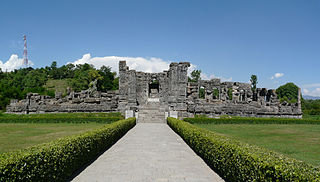
Lalitaditya alias Muktapida was a powerful ruler of the Karkota dynasty of Kashmir region in the Indian subcontinent.

Rajatarangini is a metrical legendary and historical chronicle of the north-western Indian subcontinent, particularly the kings of Kashmir. It was written in Sanskrit by Kashmiri historian Kalhana in the 12th century CE. The work consists of 7826 verses, which are divided into eight books called Tarangas ("waves").
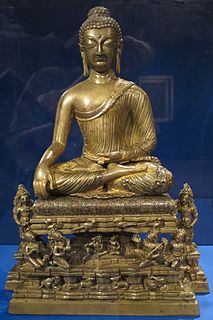
Buddhism was an important part of the classical Kashmiri culture, as is reflected in the Nilamata Purana and Kalhana's Rajatarangini. Buddhism is generally believed to have become dominant in Kashmir in the time of Emperor Ashoka, although it was widespread there long before his time, enjoying the patronage not only of Buddhist rulers but of Hindu rulers too. From Kashmir, it spread to the neighbouring Ladakh, Tibet and China. Accounts of patronage of Buddhism by the rulers of Kashmir are found in the Rajatarangini and also in the accounts of three Chinese visitors to Kashmir during 630-760 AD.

Harsha, also Harshadeva, was a Hindu king of Kashmir, India. Harsha belonged to the First Lohara dynasty, of which he was the last ruler. According to Kalhana, Harsha was built like a god and was extremely handsome. Harsha's conduct has recently been a subject of discussion. Harsha started out as a capable and noble king, then ran into financial trouble because of his spending habits. He was the son of king Kalasha of Kashmir. According to Pandit Prithvi Nath Kaul Bamzai, A History of Kashmir, pp. 143,’ Kalhana mentioned even night soil was taxed under his rule. Extravagant expenditure on his troops and senseless pleasure involved him in grave financial difficulties .His accidental discovery of hoarded treasures at the Bhimasahi, induces him to spoilage other temple and he started melting gold and silver images of god and goddess’’

Avanti was an ancient Indian Mahajanapada, roughly corresponded to the present day Malwa region. According to the Buddhist texts, the Anguttara Nikaya, Avanti was one of the solasa mahajanapadas of the 6th century BCE. The janapada was divided into two parts by the Vindhyas, the northern part had its capital at Ujjayini and the southern part had its centre at Mahishmati.

Achabal, known as Achival in Kashmiri, is a town in Anantnag district, in the union territory of Jammu and Kashmir, India.

The Major Rock Edicts of Indian Emperor Ashoka refer to 14 separate major Edicts of Ashoka which are significantly detailed and represent some of the earliest dated rock inscriptions of any Indian monarch. These edicts are preceded chronologically by the Minor Rock Edicts.

Sannati is about 3 km from Sannati. An important Jain site, the place where an ancient Buddhist Mahastupa site found. It is on the left bank of the Bhima river in Chitapur taluk, Kalaburagi district in Karnataka, India. Nalwar is the nearest Railway station about 19 km from sannati. The Buddhist site about 2.5 km from Chandrala Parameshwari temple of Sannati.

Devanampriya, also Devanampiya, was a Pali honorific epithet used by a few Indian monarchs, but most particularly the Indian Emperor Ashoka in his inscriptions. "Devanampriya" means "Beloved of the Gods". It is often used by Ashoka in conjunction with the title Priyadasi, which means "He who regards others with kindness", "Humane"

Parihaspora or Parihaspur or Paraspore or Paraspur was a small town 22 kilometres (14 mi) northwest of Srinagar in the Kashmir Valley. It was built on a plateau above the Jhelum River. It was built by Lalitaditya Muktapida (695–731) and served as the capital of Kashmir during his reign.

The Karkota Dynasty ruled over the Kashmir valley and some northern parts of the Indian subcontinent during 7th and 8th centuries. Their rule saw a period of political expansion, economic prosperity and emergence of Kashmir as a center of culture and scholarship. Founded by Durlabha Vardhan, a Kashmiri Brahmin.
Subhadrangi, also known as Dharma(Pali: Dhamma) or Janapada-Kalyani, was the wife of Samrat Bindusara and the mother of Ashoka the Great, the Maurya emperor of ancient India.
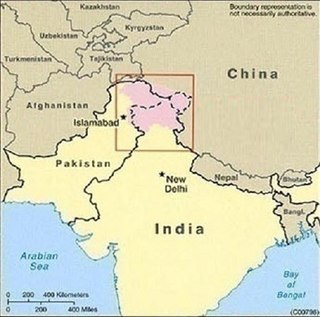
Jalauka was, according to the 12th century Kashmiri chronicle, the Rajatarangini, a king of Kashmir, who cleared the valley of oppressing Malechas. Jaluka was reputed to have been an active and vigorous king of Kashmir, who expelled certain intrusive foreigners, and conquered the plains as far as Kannauj. Jalauka was devoted to the worship of the Hindu god Shiva and the Divine Mothers, in whose honour he and his queen, Isana-devi, erected many temples in places which can be identified.
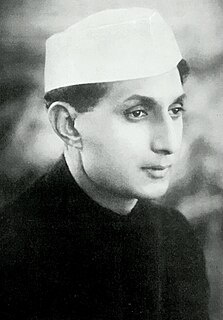
Ranjit Sitaram Pandit was an Indian barrister, Congressman, linguist and scholar from Rajkot in the Kathiawar district of British India. He is known for his role in the Indian non-cooperation movement, and for translating the Sanskrit texts Mudrarakshasa, Ṛtusaṃhāra and Kalhana's Rajatarangini into English.


















